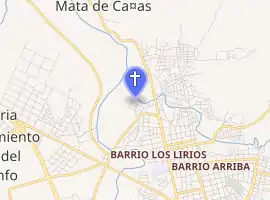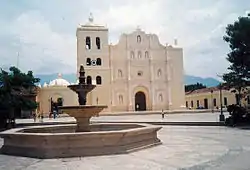Immaculate Conception Cathedral, Comayagua
The Immaculate Conception Cathedral [1] (Spanish: Catedral de la Inmaculada Concepción) also called Comayagua Cathedral[2][3] It is dedicated to the Virgin Mary and is located in the Central Square of the city of Comayagua in Honduras,[4] it is one of the oldest cathedrals in Central America, built from 1634 and inaugurated on December 8, 1711 and blessed in 1715.
| Immaculate Conception Cathedral | |
|---|---|
| Catedral de Comayagua | |
Catedral de la inmaculada concepción | |
 | |

| |
| Location | Comayagua |
| Country | |
| Denomination | Roman Catholic Church |
| Architecture | |
| Style | Baroque |
| Years built | 1685-1715 |
History
The cathedral was started by the then Bishop of Comayagua (Honduras) Alonso Vargas y Abarca, continued by Bishop Fray Juan Pérez Carpintero and finished by Bishop Fray Antonio López de Guadalupe, its construction took between 1635 and 1715 when it was solemnly blessed. According to data from the Honduran Institute of Anthropology and History (IHAH), around 18 indigenous groups worked on the construction of the Catholic monument. It also has 10 windows that illuminate its interior and it has five bodies divided by ten cruciform pilasters that form arches.
The cathedral was dedicated to Santa María, mother of Jesus of Nazareth and was built in the Central Plaza of the city. At the beginning of this century it was completely restored, as part of the rehabilitation project of the historic center of the city, a work directed by the IHAH, with the collaboration of the Spanish Cooperation Agency. Today the cathedral continues to be a focus of meeting for the people of Comayagua and one of its most valued historical sites, along with the other colonial churches, the churches of La Merced, San Francisco, San Sebastián and La Caridad.
Architecture
Inside

It consists of a Latin cross plan with three naves with a barrel vault, with five sections, the presbytery is covered with three hemispherical domes. It has an annex where the chapel of the Blessed Sacrament is located. On the main altar you can see a gilded wooden altarpiece, with a carving of the image of the Immaculate Conception and an crucifix made in 1620 by the spanish artist Francisco de Ocampo and donated to the city by King Felipe II of Spain.
It is said that originally the cathedral had 16 altarpieces or altars, however today it only has the 4 largest altars decorated with fine carved wood finishes and covered with gold sheets, others with beautiful paintings and others are adorned with beautiful images. The eight images that are distributed in the temple, were donated by Felipe VI of Spain, as well as the crucified one donated in 1620 and made by the Jaén sculptor Andrés Ocampo.
The pulpit of the Cathedral of Comayagua was built on the same date as the altarpieces, they are in the Solomonic Baroque style. The current lamps that are hanging inside the ceiling of the cathedral are replicas of the original lamps made of silver which were transferred and can be seen on display in the colonial museum of Comayagua.The temple also has an organ, which arrived in the city on December 7, 1887 and was premiered in the Cathedral of Comayagua. The organ is no longer frequently used, an exception only for Holy Week, Christmas, or Weddings.
Outside

Outside, the façade has a Renaissance and baroque style. Its made in the form of an altarpiece with three streets, the central one wider where the semicircular arch entrance door is located. The streets are divided vertically by attached columns and horizontally by cornices forming four floors. Inside some niches of this facade, there are the images of four doctors of the Church in the side streets and in the central one, on the third floor, there are the statues of the Virgin Mary and on their sides Saint John the Baptist and Saint Joseph.
Finally on the fourth floor is the figure of Christ blessing. The four-story bell tower stands out on the left side of this main façade, the last one is where the eight bells that it has are placed, later in its construction to the façade, this bell tower is finished off with a glazed colored ceramic dome.
Clock

In the tower of the cathedral there is also the oldest clock in the Americas, built by the Arabs during their occupation in Spain in the middle ages around the year 1100. Before it was transferred to the americas, it was working in the Alhambra, the arab palace in the city of Granada, the capital of the last muslim kingdom of the iberian penninsula.
On the orders of King Felipe III of Spain, it was transferred to the Hibueras region of the New Spain where it would function as the city's clock. The clock mechanism is based on gears, ropes, weights and a pendulum, the whole set shows the time on the dial located on the facade of the church where the number 4 in Roman numerals is shown as IIII and not as IV. Before being installed in the cathedral, it worked for a time in the church of La Merced, which functioned as the previous cathedral of the city until the completion of that of the immaculate conception in 1715.
During 2007 it was subjected to a restoration process by the Municipal Mayor's Office, the National Congress, the Comayagüense Cultural Committee and the supervision of the Honduran Institute of Anthropology and History, for which the master watchmaker Rodolfo Antonio Cerón Martínez from Guatemala was located , who after five months of hard work concluded his work on December 20, 2007.
There is a conflict between whether or not it is the oldest on the planet, its contender is a watch found in England and it is alleged that it is the oldest, however, it is made on the basis of cast iron and that of Comayagua in wrought iron base, of the two techniques the wrought iron is older than the one used in the English clock so it follows that the Comayagua is the oldest.
References
- Cathedral of the Immaculate Conception in Comayagua
- Arellano, Fernando (1988-01-01). El arte hispanoamericano (in Spanish). Universidad Catolica Andres. ISBN 9789802440177.
- Oyuela, Leticia de (1997-01-01). Dos siglos de amor: 26 historia de amor documentadas de la sociedad hondureña de los siglos XVIII y XIX (in Spanish). Editorial Guaymuras.
- Hernández, Bernabé Fernández (1997-01-01). El gobierno del Intendente Anguiano en Honduras, 1796-1812 (in Spanish). Universidad de Sevilla. ISBN 9788447203680.